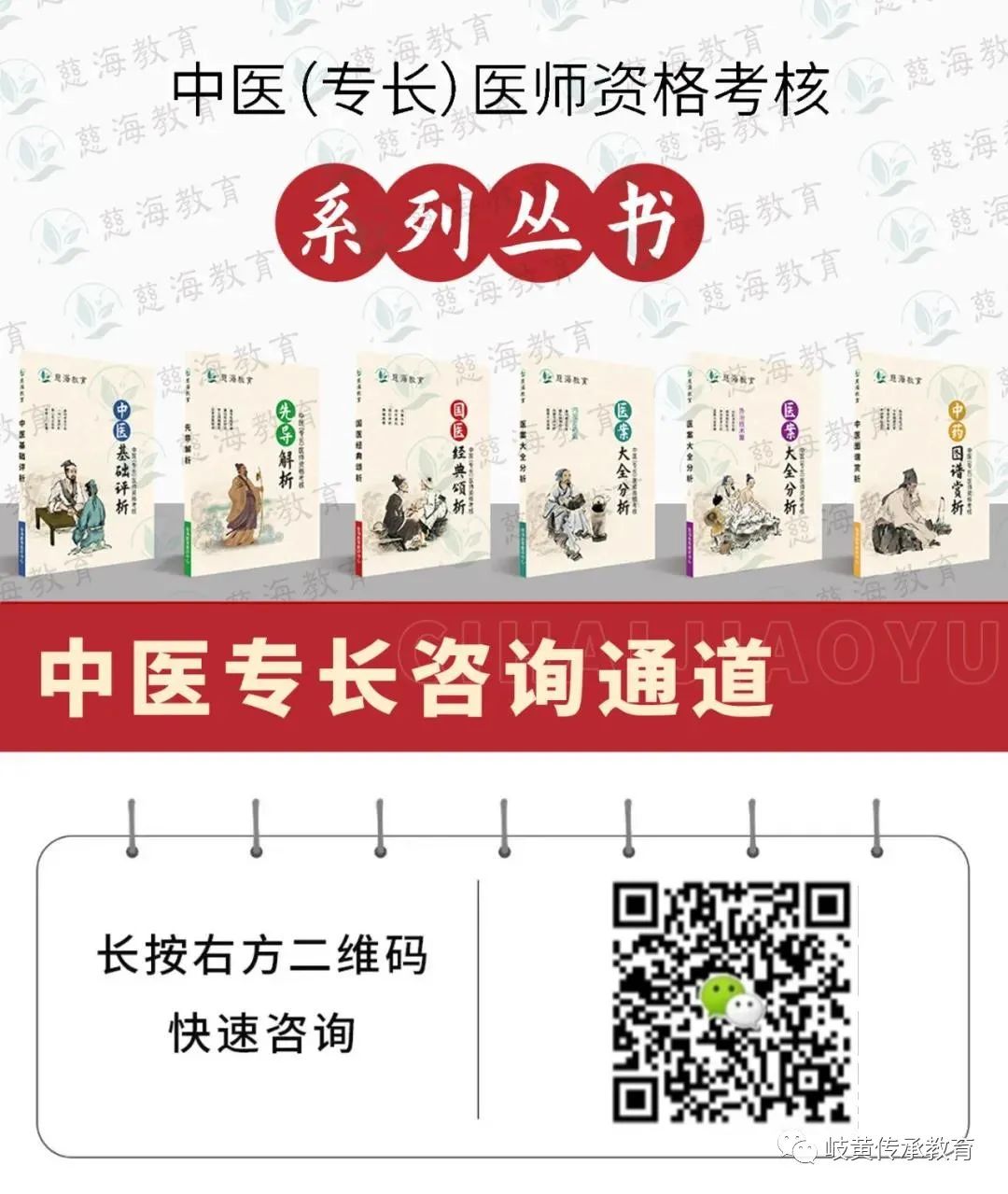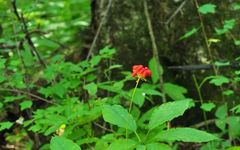
Tonifying Qi Herbs
Tonifying Herbs: These are herbs primarily used to replenish deficiencies and strengthen the body, correcting imbalances in qi, blood, yin, and yang. They are commonly used to treat deficiency syndromes and are also known as tonifying or nourishing herbs. Based on their properties, effects, and indications, tonifying herbs are generally classified into four categories: Qi tonifying herbs, Yang tonifying herbs, Blood tonifying herbs, and Yin tonifying herbs.
Qi Tonifying Herbs: This category of herbs is generally sweet and warm or sweet and neutral in nature, primarily entering the spleen and lung meridians, with some also affecting the heart and kidney meridians. Their main function is to tonify qi, which helps to replenish the qi of the organs and correct qi deficiency. Qi tonification includes specific effects such as tonifying spleen qi, lung qi, heart qi, kidney qi, and yuan qi.
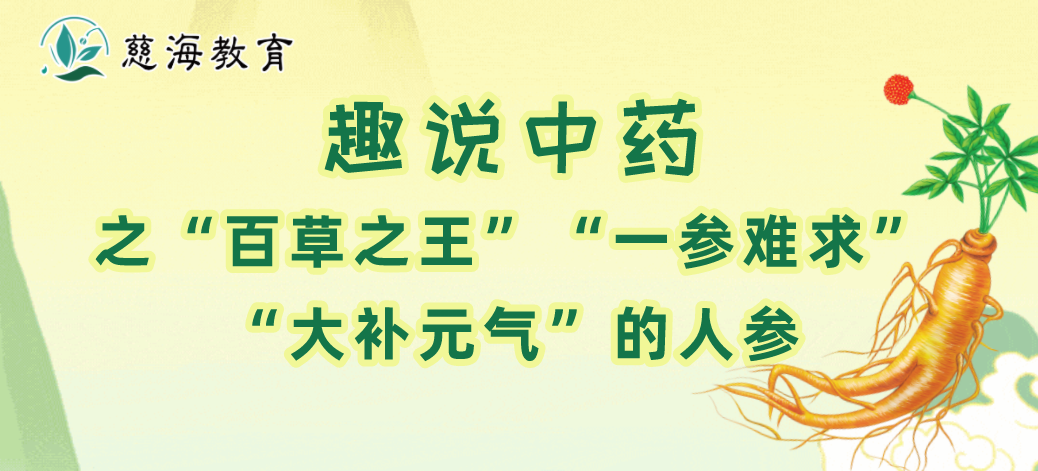
Regarding Ren Shen (Ginseng), it has been recorded in the Shen Nong’s Herbal Classic: “It primarily tonifies the five organs, calms the spirit, stabilizes the soul, stops palpitations, eliminates evil qi, brightens the eyes, opens the mind, and prolongs life with long-term use.” Ginseng is known as the “King of Herbs” and is a precious medicinal material recognized both domestically and internationally.
人参
rén shēn
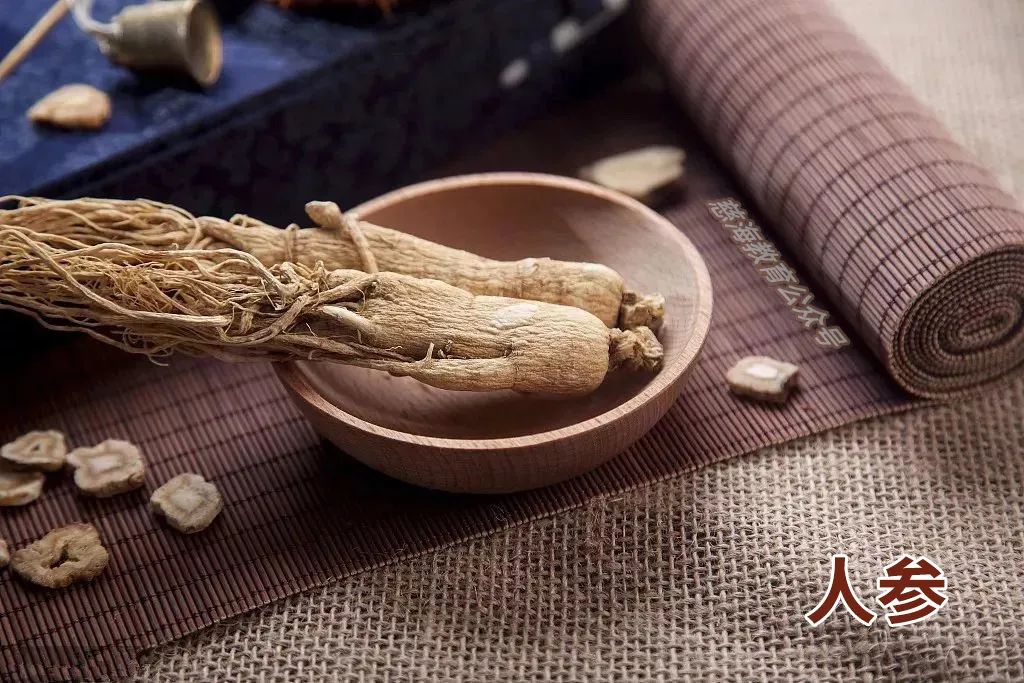
Source:
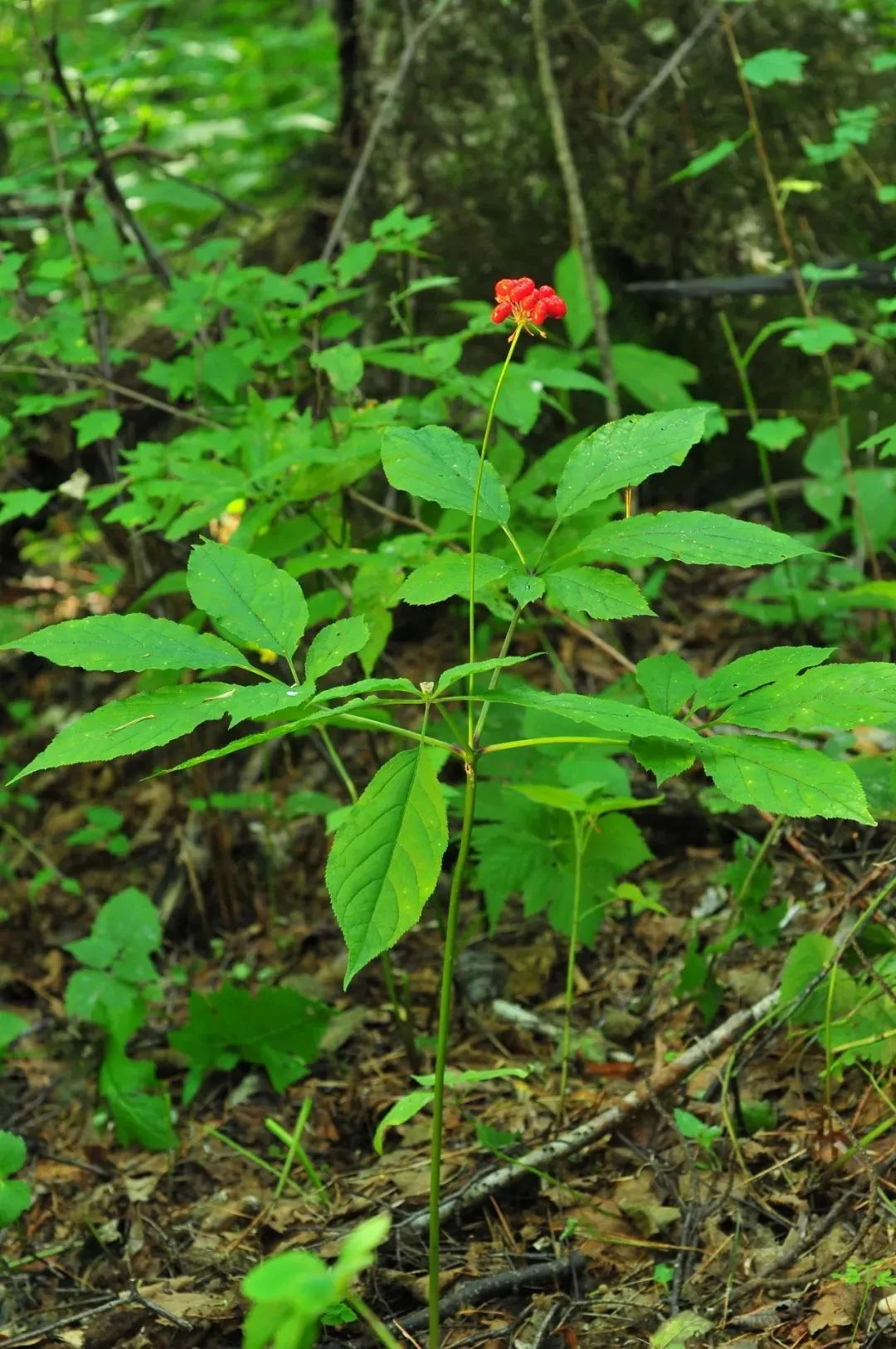
←
Ren Shen
This product is the dried root and rhizome of the plant Panax ginseng.
Wild Ginseng is called “Shan Shen”; cultivated ginseng is commonly referred to as “Yuan Shen”. Ginseng that grows naturally in the wild is called “Lin Xia Shan Shen”, commonly known as “Seed Sea.” Cultivated ginseng is dried in the sun or baked, referred to as “Sheng Shai Shen”; wild ginseng that is dried in the sun is called “Sheng Shai Shan Shen”; ginseng that is blanched in water and dried after soaking in sugar is called “Bai Tang Shen”; and ginseng that is steamed and then dried is called “Hong Shen.”
Harvested mainly in autumn, cleaned, dried in the sun or baked. It is then sliced thinly, dried, or crushed when needed. This product has a unique aroma, with a slightly bitter yet sweet taste. The best quality has a light yellow-white cut surface with many resin ducts. Used raw.
Related Names:
Ren Xian, Gui Gai (in Ben Jing), Tu Jing, Shen Cao, Huang Shen, Xue Shen (in Wu Pu Ben Cao), Di Jing (in Guang Ya), Bai Chi Chu (in Ben Cao Tu Jing), Hai Yu, Jin Jing Yu Lan, Hai Er Shen (in Gang Mu), Bang Chui (in Liaoning Major Medicinal Materials).
Origin:
Primarily produced in Jilin, Liaoning, and Heilongjiang, traditionally, the highest quality and largest quantity comes from Fusong County in Jilin, known as Jilin Shen.
Properties and Meridian Affinities:
Sweet, slightly bitter, slightly warm. Enters the spleen, lung, heart, and kidney meridians.
Functions:
Greatly tonifies yuan qi, restores pulse, stabilizes collapse, tonifies spleen and benefits lung, generates fluids and nourishes blood, calms the spirit and benefits intelligence.
Identification of Properties:
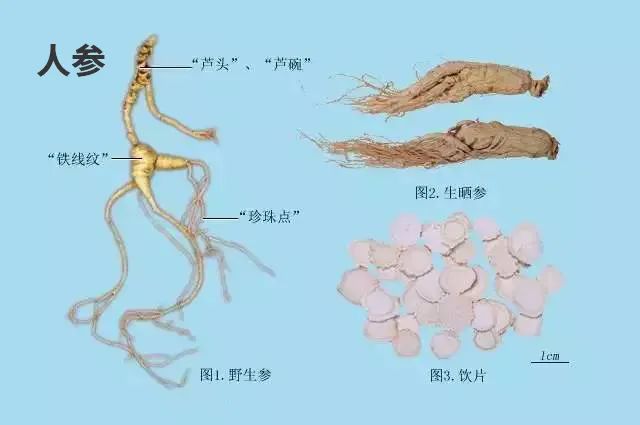 Ren Shen
Ren Shen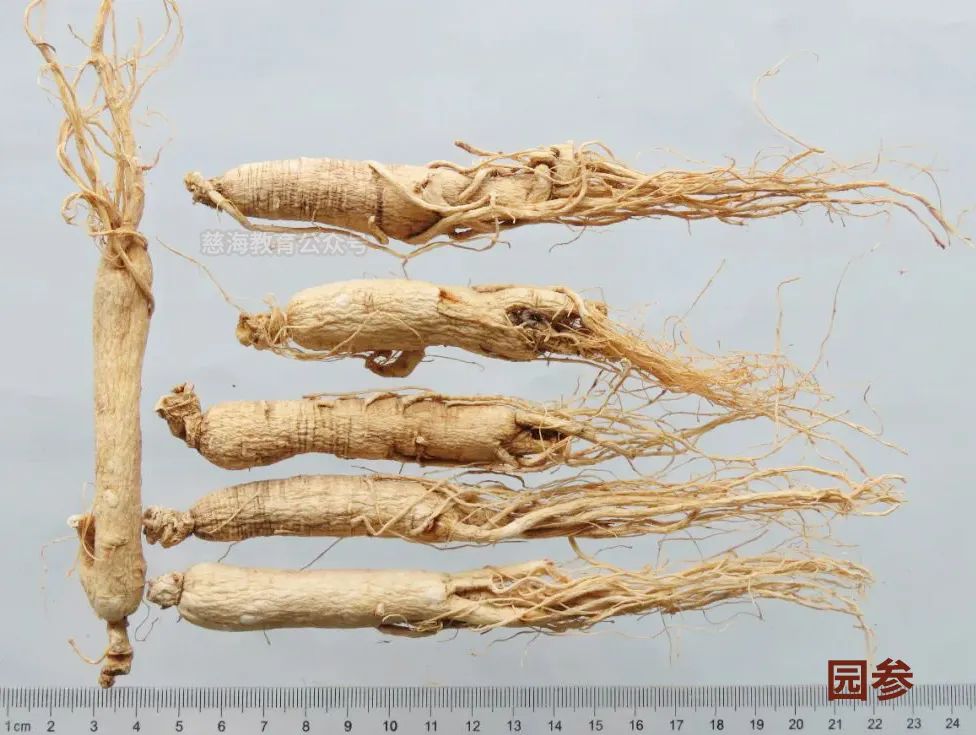
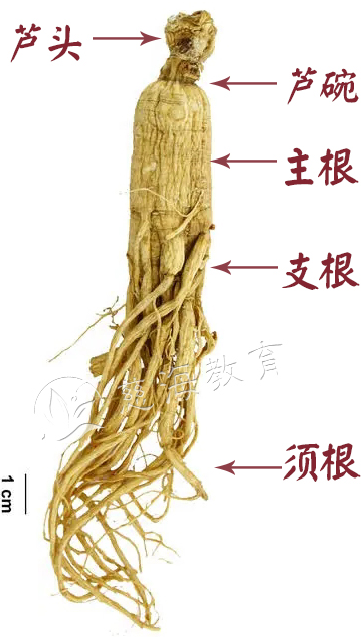
Properties of the Medicinal Material::
Sheng Shai Shen: The main root is spindle-shaped or cylindrical, 3-15 cm long, 1-2 cm in diameter. The surface is grayish-yellow, with shallow, intermittent coarse transverse wrinkles and obvious longitudinal folds. The lower part has 2-3 lateral roots and many long fibrous roots, often with small, inconspicuous warty protrusions. The rhizome (the root head) is 1-4 cm long, 0.3-1.5 cm in diameter, often twisted and curved, with irregular roots and sparse, pit-like stem scars (the root bowl). The texture is relatively hard, with a light yellow-white cross-section, showing a powdery appearance, with brownish-yellow ring patterns in the cambium layer, and the bark has yellow-brown resin ducts and radial fissures. The aroma is unique, with a slightly bitter and sweet taste.
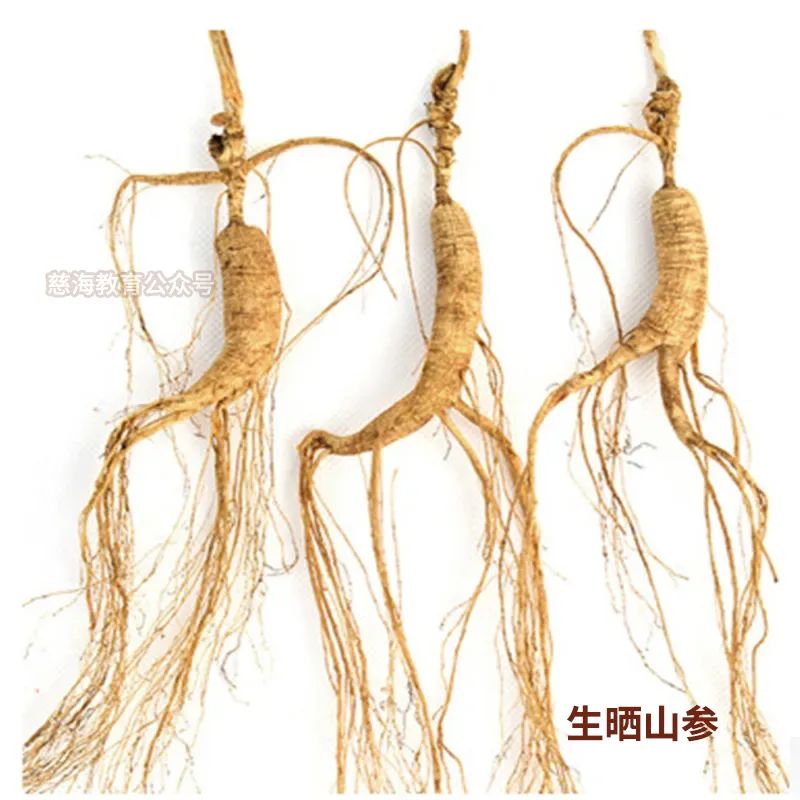
Sheng Shai Shan Shen: The main root and rhizome are of equal length or shorter, shaped like a human character, diamond, or cylindrical, 2-10 cm long. The surface is grayish-yellow, with longitudinal wrinkles, and the upper end has tightly packed, deeply sunken circular transverse wrinkles. The lateral roots are mostly 2, with long, clear, and orderly fibrous roots, having obvious warty protrusions, commonly referred to as “pearl bumps.” The rhizome is slender, with dense stem scars at the top, and the irregular roots are relatively thick, resembling jujube pits.
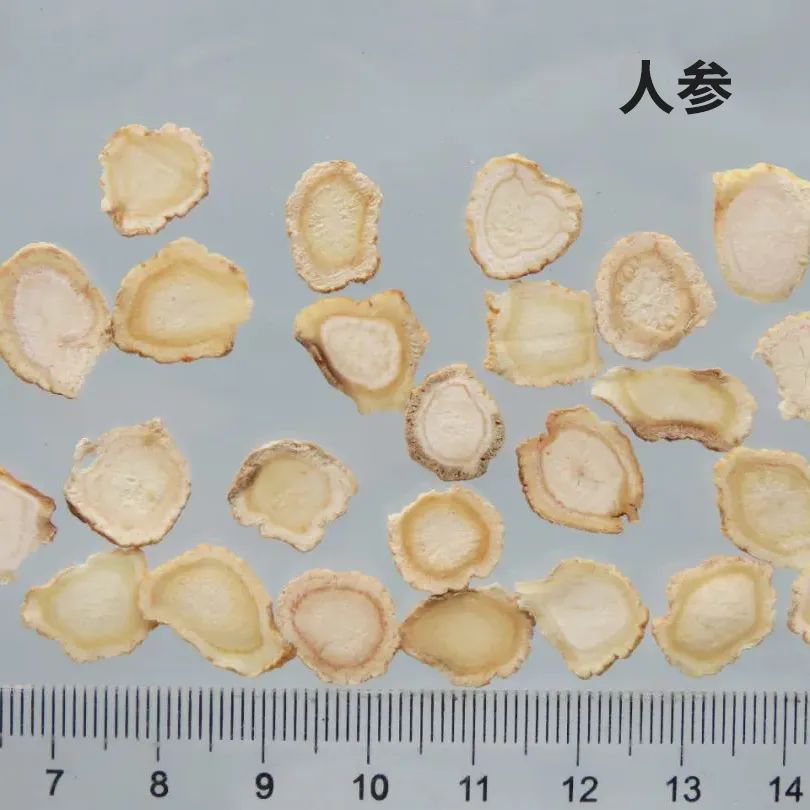
Ginseng slices
【Slice Properties】Moist, thinly sliced, dried, or crushed when needed.
Ginseng Slices This product appears as round or nearly round thin slices. The outer skin is grayish-yellow. The cut surface is light yellow-white or whitish, showing a powdery appearance, with brownish-yellow ring patterns in the cambium layer, and the bark has yellow-brown resin ducts and radial fissures. It is light in weight and brittle. The aroma is unique, with a slightly bitter and sweet taste.
Indications:
1. Qi deficiency with a desire to collapse, cold limbs, and weak pulse
This product is sweet and warm, tonifying deficiency, greatly replenishing yuan qi, restoring pulse, and stabilizing collapse, making it a crucial medicine for rescuing from critical conditions. In cases of excessive sweating, vomiting, diarrhea, significant blood loss, or severe illness leading to extreme qi deficiency with a weak pulse, continuous sweating, and a pulse that is about to stop, large doses of ginseng can be used in decoction, such as in Du Shen Tang (in Jing Yue Quan Shu). If qi deficiency with a desire to collapse is accompanied by sweating and cold limbs, indicating a loss of yang, it is often used with Fu Zi (Aconite) to tonify qi and stabilize collapse, restoring yang, such as in Shen Fu Tang (in Zheng Ti Lei Yao). If qi deficiency with a desire to collapse is accompanied by sweating, warm body, thirst for cold drinks, and a red, dry tongue indicating a loss of yin, this product can also generate fluids, often used with Mai Dong (Ophiopogon) and Wu Wei Zi (Schisandra) to tonify qi, nourish yin, and restrain sweating, such as in Sheng Mai San (in Nei Wai Shang Bian Huo Lun).
2. Spleen deficiency with poor appetite, lung deficiency with cough and asthma, impotence and cold in the palace
This product enters the spleen meridian and is a key herb for tonifying spleen qi. In cases of weak spleen qi, fatigue, poor appetite, and loose stools, it is often used with Bai Zhu (Atractylodes) and Fu Ling (Poria) and Gan Cao (Licorice), such as in Si Jun Zi Tang (in He Ji Ju Fang). If spleen qi deficiency leads to blood loss, this product can also tonify qi to restrain blood, often used with Huang Qi (Astragalus) and Bai Zhu to benefit qi and strengthen the spleen, such as in Gui Pi Tang (in Ji Sheng Fang).
This product also enters the lung meridian and is effective in tonifying lung qi. In cases of weak lung qi, weak cough, shortness of breath, low voice, clear and thin phlegm, spontaneous sweating, and weak pulse, it is often used with Huang Qi, Wu Wei Zi, and Zhi Wan (Aster), such as in Bu Fei Tang (in Qian Jin Fang).
This product also enters the kidney meridian and has the function of benefiting kidney qi and assisting kidney yang. In cases of shortness of breath due to kidney not receiving qi or prolonged asthma, often used with Ge Jie (Gecko) and Hu Tao Ren (Walnut), such as in Ren Shen Ge Jie San (in Wei Sheng Bao Jian) and Ren Shen Hu Tao Tang (in Ji Sheng Fang). If treating kidney yang deficiency, kidney essence deficiency, impotence, and cold in the palace, it is often used with Lu Rong (Deer Antler) and Rou Cong Rong (Cistanche) to tonify kidney yang and benefit kidney essence.
3. Qi deficiency with fluid damage and thirst, internal heat with diabetes
This product can both tonify qi and generate fluids. It is suitable for cases of qi and fluid damage, shortness of breath, and thirst. When treating febrile diseases with qi and fluid damage, body heat, irritability, dry mouth and tongue, profuse sweating, and a weak pulse, it is often used with Shi Gao (Gypsum) and Zhi Mu (Anemarrhena) such as in Bai Hu Jia Ren Shen Tang (in Shang Han Lun). For diabetes with qi and yin damage, ginseng can tonify the qi of the lung, spleen, and kidney while generating fluids and stopping thirst, thus it is commonly used in formulas for diabetes.
4. Qi and blood deficiency, prolonged illness with deficiency
This product is sweet and can tonify qi to generate blood and nourish blood. In cases of spleen qi deficiency, where qi deficiency cannot generate blood, leading to both qi and blood deficiency, and prolonged illness with deficiency, it can be used with Bai Zhu, Dang Gui (Angelica), and Shu Di Huang (Rehmannia) such as in Ba Zhen Tang (in Rui Zhu Tang Experience Formula).
5. Insufficient heart qi, palpitations, and insomnia
This product enters the heart meridian and can tonify heart qi, calm the spirit, and benefit intelligence. It is suitable for cases of weak heart qi, palpitations, anxiety, chest tightness, shortness of breath, insomnia with many dreams, and forgetfulness, often used with Huang Qi, Fu Ling, and Suan Zao Ren (Sour Jujube Seed).
If both heart and spleen are deficient, with insufficient qi and blood, leading to palpitations and insomnia, fatigue, and poor appetite, it is often used with Huang Qi, Dang Gui, and Long Yan Rou (Longan) to tonify qi, nourish blood, and calm the spirit, such as in Gui Pi Tang (in Ji Sheng Fang). If there is disharmony between heart and kidney, with yin deficiency and blood loss, leading to insomnia and palpitations, it is often used with Sheng Di Huang, Dang Gui, and Suan Zao Ren to nourish yin, generate blood, and calm the spirit, such as in Tian Wang Bu Xin Dan (in She Sheng Mi Po).
Additionally, this product is often used with exterior-releasing herbs and purgative herbs for cases of qi deficiency with external pathogens or internal heat accumulation leading to deficiency of righteous qi, having the effect of supporting righteousness and expelling evil, such as in Ren Shen Bai Du San (in He Ji Ju Fang) and Xin Jia Huang Long Tang (in Wen Bing Tiao Bian).
Dosage:
Decoct, 3-9 g; for rescuing from collapse, can use 15-30 g, decocted separately. It can also be powdered and taken, 2 g per dose, twice a day.
Precautions:
Should not be used with Li Lu or Wu Ling Zhi.
Modern Research:
1. Chemical Composition: It mainly contains various triterpenoid saponins such as ginsenosides Ro, Ra1, Rb1, Re, Rg1, as well as polysaccharides, volatile oils, amino acids, organic acids, flavonoids, vitamins, and trace elements. The Chinese Pharmacopoeia stipulates that this product must contain at least 0.30% of the total ginsenosides Rg1 and Re, and the slices must contain at least 0.27%; ginsenoside Rb1 must be at least 0.20%, and the slices must contain at least 0.18%.
2. Pharmacological Effects: Ginsenosides and their injections have anti-shock effects. Ginsenosides can enhance digestion and absorption, increase gastric protease activity, protect gastrointestinal cells, and improve symptoms of spleen deficiency; they can promote tissue utilization of glucose, accelerate glucose oxidation and decomposition to provide energy; they can enhance brain utilization of energy substances, improve learning and memory; they can promote hematopoiesis; they also have anti-fatigue, anti-aging, anti-myocardial ischemia, anti-cerebral ischemia, and anti-arrhythmic effects. Ginseng extract and ginsenoside Rb can increase red blood cells, white blood cells, and hemoglobin levels in normal or anemic animals. Ginseng polysaccharides and injections have a leukocyte-enhancing effect. Ginsenoside Rg2 has a cardiotonic effect. Additionally, ginseng can regulate the balance between central nervous system excitation and inhibition, enhance immune function, exhibit anti-tumor, anti-radiation, anti-stress, lower blood lipids, lower blood sugar, and have diuretic effects.
Others:
In the 1970s, foreign scholars observed 133 patients who had been using ginseng for a long time over two years. The results indicated that long-term ginseng users exhibited symptoms and signs such as excitement, morning diarrhea, rashes, insomnia, nervousness, hypertension, euphoria, edema, increased libido, decreased appetite, depression, hypotension, and amenorrhea, which were similar to those seen in corticosteroid poisoning.
Associated Herbs: Red Ginseng, Ginseng Leaves
1. Red Ginseng
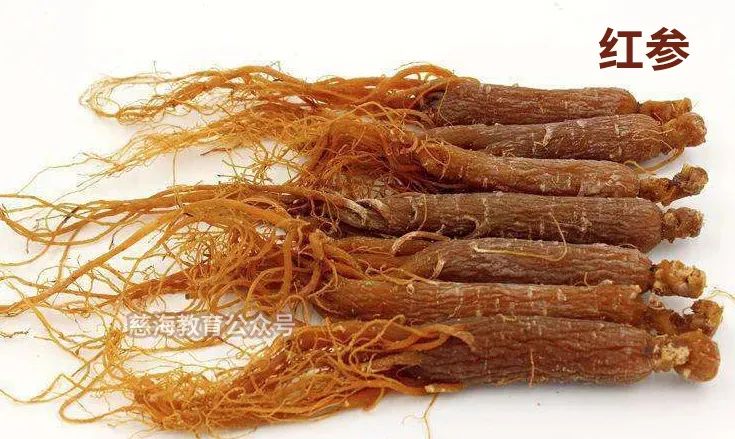
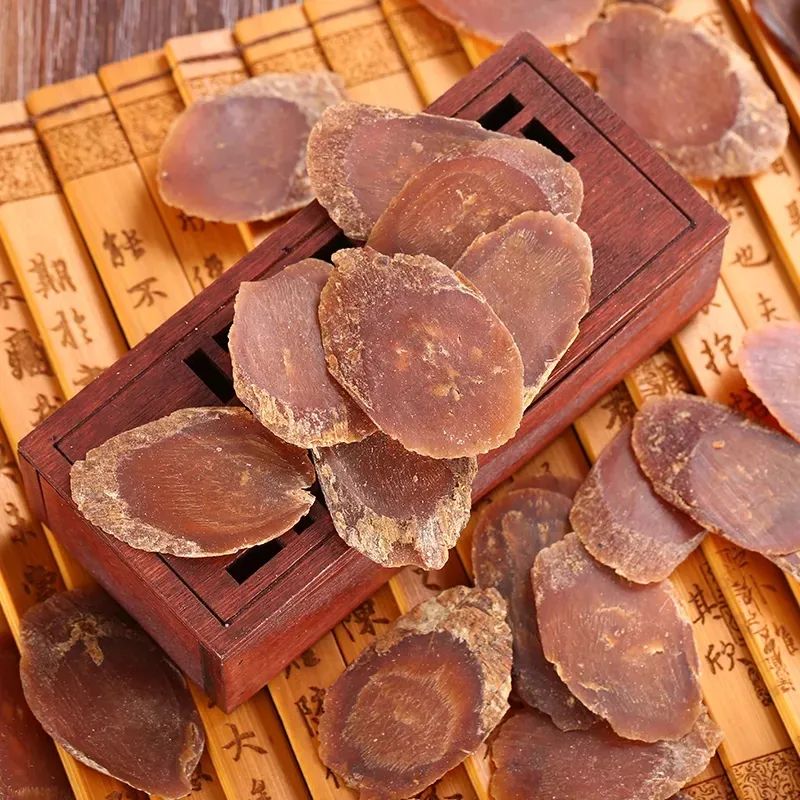
This product is the dried root and rhizome of the cultivated plant Panax ginseng C.A.Mey. after steaming. It is sweet, slightly bitter, and slightly warm; it enters the spleen, lung, heart, and kidney meridians. Its functions include greatly tonifying yuan qi, restoring pulse, stabilizing collapse, and benefiting qi and restraining blood, suitable for those with body weakness and a desire to collapse, cold limbs, and weak pulse. Decoction, 3-9 g, can be decocted separately. Should not be used with Li Lu or Wu Ling Zhi.
2. Ginseng Leaves
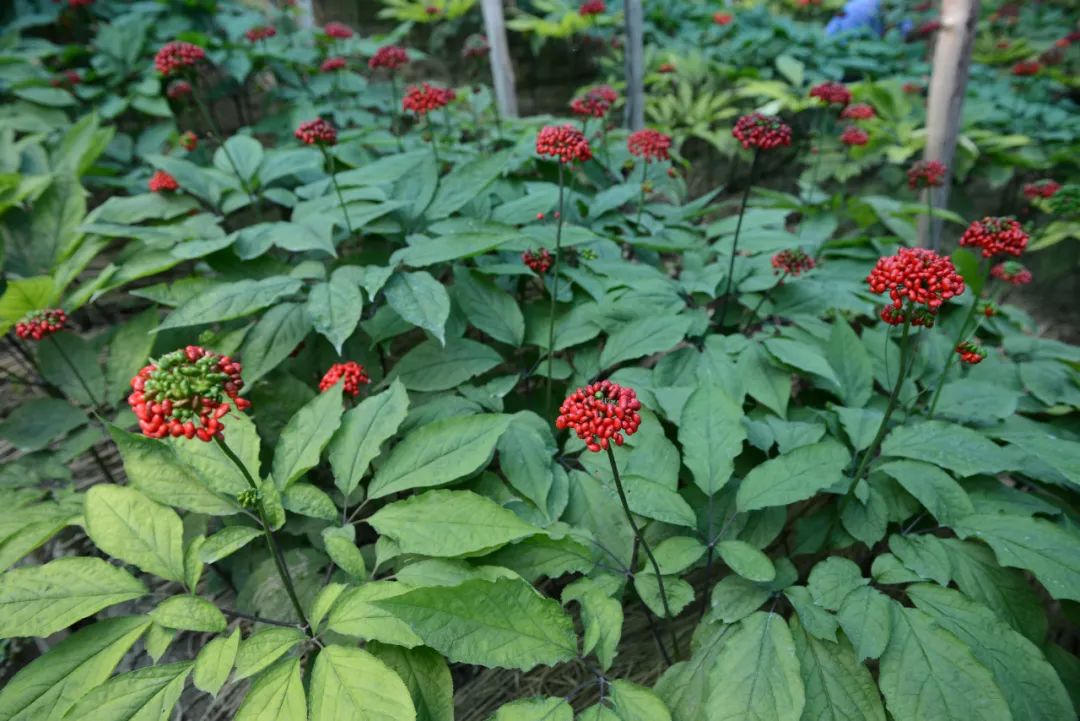 This product is the dried leaves of the plant Panax ginseng C.A.Mey. It is bitter and sweet, cold in nature; it enters the lung and stomach meridians. Its functions include tonifying qi, benefiting the lung, dispelling summer heat, and generating fluids. It is suitable for qi deficiency cough, summer heat irritability, fluid damage thirst, dizziness, and fatigue. Decoction, 3-9 g. Should not be used with Li Lu or Wu Ling Zhi.
This product is the dried leaves of the plant Panax ginseng C.A.Mey. It is bitter and sweet, cold in nature; it enters the lung and stomach meridians. Its functions include tonifying qi, benefiting the lung, dispelling summer heat, and generating fluids. It is suitable for qi deficiency cough, summer heat irritability, fluid damage thirst, dizziness, and fatigue. Decoction, 3-9 g. Should not be used with Li Lu or Wu Ling Zhi.
Ginseng broadly refers to a general term that includes wild mountain ginseng, transplanted mountain ginseng, sun-dried ginseng, white ginseng, red ginseng, and American ginseng, etc. These names are distinguished based on the growth environment, growth conditions, growth period, and processing methods.Classification of Ginseng
(1) Classification by Origin (Variety):
Domestic ginseng, Korean ginseng, Canadian American ginseng, American ginseng, Russian ginseng, Japanese ginseng.
(2) Classification by Growth Environment:
Wild mountain ginseng, forest-grown ginseng (seed sea), transplanted mountain ginseng, cultivated ginseng.
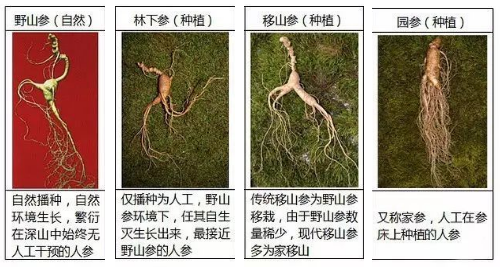 Comparison of Ginseng Shapes in Different Growth Environments
Comparison of Ginseng Shapes in Different Growth Environments
(3) Classification by Processing Method:
Sun-dried ginseng, red ginseng, white dried ginseng, sugar ginseng, strong ginseng, light sugar ginseng, peeled ginseng, active ginseng, fresh ginseng, tail ginseng, purple-red ginseng, honey ginseng, water ginseng, ginseng hairs, and processed ginseng.
Wild Mountain Ginseng: This is wild ginseng, which is now very rare and very expensive, but has strong effects.
Transplanted Mountain Ginseng: This is ginseng that has been transplanted from wild mountain ginseng seedlings to cultivated land or small cultivated ginseng that has been transplanted to the wild. The yield of transplanted mountain ginseng is relatively low, and the price is higher. Many of the so-called wild mountain ginseng on the market are actually transplanted mountain ginseng.
Cultivated Ginseng: This is artificially cultivated ginseng, which has a high yield and lower price, and is the most common in the market. Depending on the processing method, it is divided into white ginseng and red ginseng. White ginseng includes sun-dried ginseng, sugar ginseng, etc.
Sun-dried Ginseng: This is cultivated ginseng that is cleaned and dried in the sun.
Sugar Ginseng: This is cultivated ginseng that is blanched in boiling water, soaked in sugar juice, and then dried. This type of ginseng should be used with caution by diabetic patients.
Red Ginseng: This is cultivated ginseng that is cleaned, steamed for 2-3 hours, and then dried. Korean ginseng is also red ginseng.
American Ginseng: Also known as flower flag ginseng, originally from the United States and Canada, now also cultivated in China.
Different classifications of ginseng have different effects and are suitable for different populations.Wild Mountain Ginseng: This is the top quality among ginseng, neutral in nature, and is a great tonic. Its best effect is to rescue from collapse, especially suitable for patients needing to greatly replenish yuan qi, the elderly and weak, and those recovering from illness or suffering from neurasthenia.Sun-dried Ginseng: Neutral in nature, it can tonify yuan qi, benefit the spleen and lung, generate fluids and stop thirst, calm the spirit and benefit intelligence, and can be used as a daily health supplement. In terms of the digestive system, when used with Bai Zhu and Fu Ling, it is particularly suitable for patients with post-illness weakness, spleen and stomach weakness, and poor digestive absorption, helping to accelerate the recovery of yuan qi. In treating neurasthenia, sun-dried ginseng can calm the spirit, stop palpitations, eliminate mental confusion, reduce fatigue, and enhance brain power.Red Ginseng: Warm in nature, it can greatly tonify yuan qi, restore pulse, stabilize collapse, and benefit qi and restrain blood, making it the first choice for those with yin excess and yang deficiency, and insufficient qi and blood, suitable for use in autumn and winter. Symptoms such as frequent coldness, cold hands and feet, dizziness, fatigue, shortness of breath, cold sensation in the stomach, long-term diarrhea, insomnia with many dreams, impotence, and frequent urination can all be treated with red ginseng. Due to its strong and fiery nature, it is not suitable for those with yin deficiency and excess fire, or hypertension.American Ginseng: Cool in nature, it can tonify qi and nourish yin, clear heat and generate fluids, suitable for use in spring and summer. It is appropriate for symptoms of yin deficiency and excess fire, internal heat, irritability, diabetes, and dry mouth and throat; chewing American ginseng can alleviate symptoms of gum swelling and pain. Due to its heat-clearing and fluid-generating properties, it is not suitable for those with heavy dampness or spleen and stomach weakness, and should not be used during menstruation.
Precautions for Taking Ginseng
1. People with allergies should avoid it; if a rash occurs after taking ginseng, it should not be used. It should not be used in cases of purulent inflammation.
2. Hypertensive patients should use it with caution.
Hypertensive patients with liver yang hyperactivity may easily experience cerebrovascular accidents after taking it, but those with cold and deficient hypertension can use ginseng, though in small amounts; if systolic blood pressure exceeds 180 mmHg, ginseng should not be used regardless of the type of patient.
3. Generally, ginseng should not be taken during colds and fevers.
During fever, palpitations can be severe, and taking ginseng may increase blood circulation, worsening palpitations and exacerbating the condition.
4. Those with the following symptoms should avoid ginseng:
Due to sudden qi obstruction leading to asthma, dryness of the throat caused by heat, or sudden impulsive bleeding, such as hemoptysis or epistaxis.
5. Edema caused by damp-heat obstruction may worsen after taking ginseng, as ginseng has an anti-diuretic effect. Additionally, those with renal insufficiency and low urine output should use it with caution.
6. Insomnia and irritability due to excess conditions should not take ginseng, as it may worsen sleep.
7. Cooking utensils are also important; whether decocting or stewing, avoid using metal utensils.
8. When taking ginseng, it is not advisable to drink tea or eat radishes, as both of these foods have qi-moving effects, while ginseng greatly tonifies yuan qi, which may counteract its effects.
9. Ginseng should not be eaten with grapes, as grapes contain tannins that can easily combine with the proteins in ginseng to form precipitates, affecting absorption and reducing efficacy.
10. Healthy children should not take it to prevent precocious puberty.
11. Should not be used in combination with Li Lu or Wu Ling Zhi.
 Save and share to learn about TCM knowledge
Save and share to learn about TCM knowledge
Note: The content and images are sourced from textbooks and the internet for educational purposes only. All formulas and treatment methods mentioned are for reference and should not be used by non-professionals.
